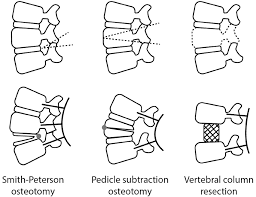Spinal osteotomies are procedures performed to correct spinal deformities such as kyphosis and scoliosis. These conditions can cause an abnormal curvature in the spine, leading to pain, discomfort, and even difficulty breathing. In these procedures, the deformed spinal bones are broken or released at various points to bring them back to their normal position. There are different types of spinal osteotomies, each one tailored to the extent of release needed. These include the Smith Peterson osteotomy, Pedicle subtraction osteotomy, and Vertebral column resection. In all these procedures, certain bones are removed and the deformity is corrected using pedicle screws with a hinge of movement acting at different points depending on the type of osteotomy.
Smith Peterson Osteotomy: The Smith Peterson osteotomy also called as Ponte osteotomy involves removing posterior spinal elements such as facets, lamina, and ligaments to correct a 15-degree deformity with a hinge of motion at the disc.
Pedicle Subtraction Osteotomy: The Pedicle subtraction osteotomy removes the entire posterior structures and a wedge of vertebral bone to correct a 30-degree deformity with a hinge of movement at the apex of the removed wedge.
Vertebral Column Resection: The most complex and rigid spinal deformities may require a Vertebral column resection also called as vertebrectomy, where the entire vertebra, including the discs above and below, is removed and replaced with a cage acting as a hinge of motion for correction.
These procedures offer hope for patients suffering from spinal deformities, improving their quality of life and overall well-being.

